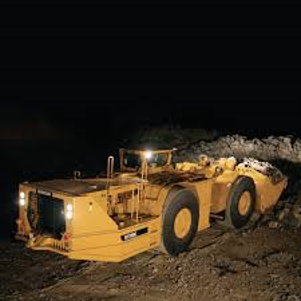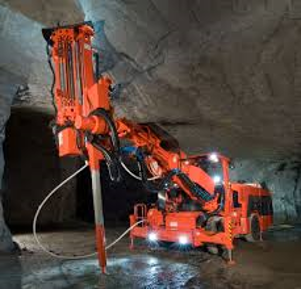Mining Techniques in Ireland
This is a general overview of mining techniques used in Irish Mines and is not exhaustive or restrictive.
Tunnel Development
 | Tunnels are generally developed by drilling and blasting of the rock. The rock is drilled using a drilling rig often known as a 'Jumbo', the drill rods can drill holes up to 6 metres in length and each hole is loaded with explosives and blasted using a detonating system. |
 | The roof is then 'scaled' by the miners to remove any loose rock using scaling bars, loose rock can also be removed mechanically using a scaling machine |
 | The blasted rock is removed using a loading shovel often referred to as a scoop |
 | Roof support depends on the scheme of support of the mine, the local mining conditions and known geological factors. Iin some mining areas the rock may be competent so that further support methods are unnecessary. In some mines steel bolts of a length between 1.2 and 2.4 metres are drilled and inserted into the roof, anchored by resin or grout and tensioned to support the roof by a combination of laminating weak beds of rock and anchoring to competent layers of rock |
 | Shotcreting (a sprayed reinforced concrete) is used in some Irish Mines to support the roof, local rules and conditions determine if and when shotcreting is required and the thickness to be applied. Fibres are often added to the mix to improve the strength of the shotcrete |
 | Where a junction of tunnels is created then it may be necessary to use 'cable bolting' to supplement other support techniques,the holes are drilled with a rock bolting machine to a pre-determined length between 10 and 25 metres long and then the cables are inserted, tensioned and grouted and provide a similar role to the rock bolts but over a longer vertical distance. The cables are lengths of spliced steel cable. Roof bolts provide immediate support but cable bolts are only effective after they have been grouted and tensioned. |
Ore/Mineral Production.
Stoping | Stoping is commonly used in Irish Mines where the ore deposit is quite thick and involves the drilling of radial holes above or below the tunnel and the tunnel retreated back. This is often referred to as 'footwall' and 'hanging wall' mining where the footwall is at the base of the deposit and the hanging wall is at the top, stoping usually involves the drilling of long holes and a large amount of explosives are inserted and blasted, 'mucking out' of the ore can take several days due to the volume of rock blasted. As the ground is exposed the 'mucking' is carried out using loading shovels (scoops) operated remotely by the operator who is located in a position of safety, the rock is then often loaded into large trucks and taken out of the mine or to the crushing/hoisting operation underground |
Benching | The production method depends upon the individual mine or the deposit being worked., in Gypsum mines and in some ore mines the ore/mineral is won by benching techniques, this involves the original tunnel being constructed to its identified boundary and the ore is won by a series of lifts where the tunnel height and width is increased by drilling the floor, roof and sides and blasting the rock. The tunnel is then retreated back. This method is used where the orebody/mineral deposit is relatively thin and horizontal. |
Backfilling | Backfilling is where the void remaining following extraction of the ore or mineral is filled using a mixture of sand, cement and crushed waste rock - this solidifies and gains in strength over a period of time and allows extraction to be carried out adjecent to the area and thereby increases the percentage of ore that can be extracted, it also allows for the disposal of waste rock from the mine surface. This technique is used following stoping and benching operations |
